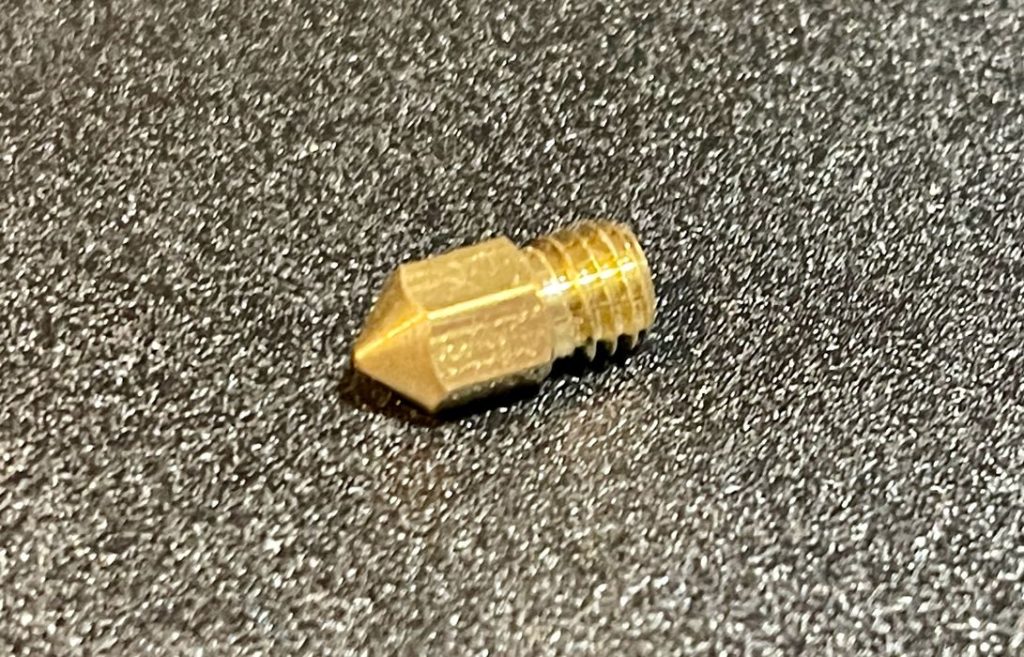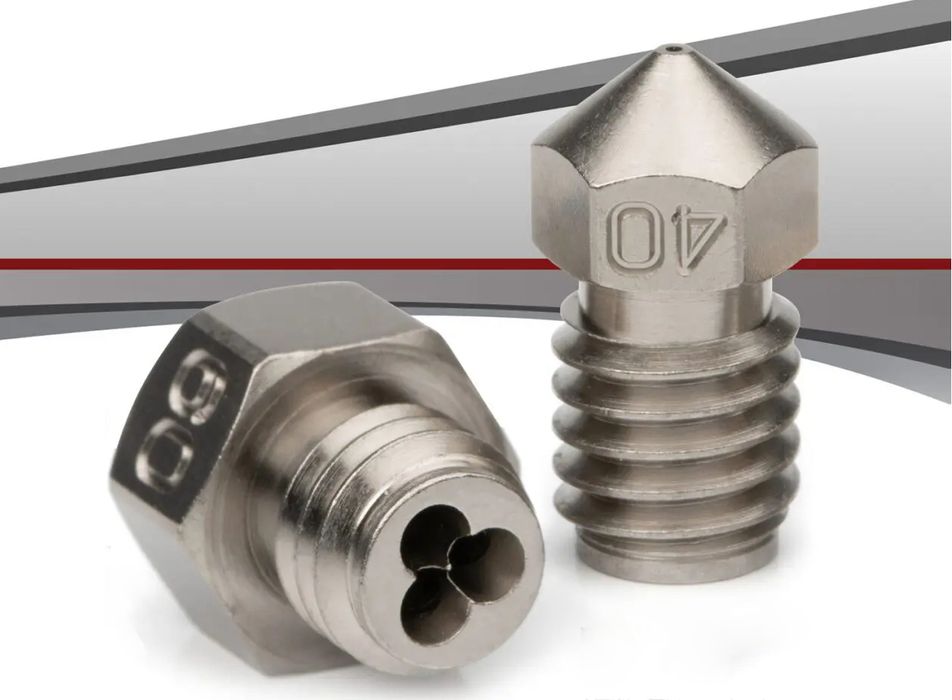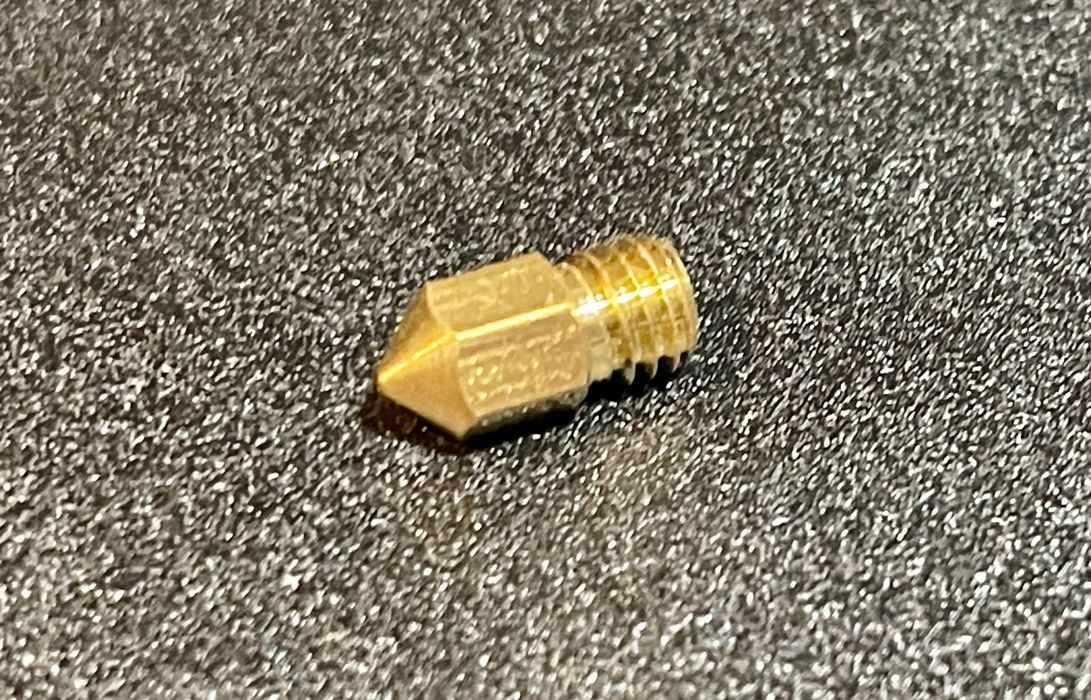
What are the properties of 3D printer nozzles, and what do they mean?
A long time ago the idea of a 3D printer nozzle for a FFF device was quite simple: it was a 0.4mm brass nozzle, hopefully with a thread pattern to match your hot end.
But times have changed and choosing a nozzle is a bit more complex.
Of course, many 3D printer operators don’t choose their 3D printer nozzle at all: they simply use the nozzle that came with the machine. That works, but often creates limitations in materials and possibly can result in the need for a replacement in the future.
The main characteristics of a FFF 3D printer nozzle are:
- Diameter
- Compatibility
- Durability
- Heat Flow
- Wear Resistance
Let’s take a look at each.
3D Printer Nozzle Diameter
This is the most familiar specification for FFF 3D printer nozzles, and it simply refers to the diameter of the orifice through which softened plastic is pushed.
The standard diameter for most devices is 0.4mm, but there are a few machines that ship with 0.5mm nozzles.
That said, many machines offer the possibility of swapping nozzles with others of different diameter. For example, a 0.25mm nozzle would enable much finer details to be 3D printed, but would also significantly add to the print duration.
On the other hand, larger diameters are used to deposit more material in the same time, thus speeding up print durations. However, that’s at the cost of print quality, and some prints may exhibit extremely coarse layer lines. However, that may be OK in many applications, particularly for larger sized prints.
Large size nozzles are typically available in sizes of 0.6, 0.8 and 1.0 mm diameters. Larger diameters are possible, but usually found only on specialized equipment.
3D Printer Nozzle Compatibility
This answers the question of whether the nozzle will fit on your particular hot end. Many machines follow standards, but some have their own for various reasons. It’s best to check the compatibility list provided by the nozzle manufacturer to see if it matches your equipment before purchasing.
The compatibility is basically a combination of the thread pattern and the length of the nozzle. Some hot ends require a longer nozzle as they have a different thermal design.
3D Printer Nozzle Durability
Durability is a function of the base material for the nozzle. While the default nozzle material for many machines is brass, that’s a rather soft material that can distort over time due to encounters with wrenches, high heat and other factors.
You’ll see some nozzles made from steel, which is a lot harder and durable. It’s also possible to obtain nozzles made of tungsten, which can withstand really high temperatures. Generally the brass nozzles are low-end, and alternatives will be more durable.
3D Printer Nozzle Heat Flow
Heat flow is a critical aspect of any FFF 3D printer nozzle, as that’s the ultimate purpose of the nozzle: convey heat through the incoming filament and quickly soften it. If the heat transfer is inefficient, then the print speed must be slowed down to allow more time for the heat to penetrate the filament material. If you’re printing too fast for the heat transfer, the material won’t be quite softened when it hits the tip and you may have a jam.
In other words, the more efficient the heat transfer of the nozzle, the faster you can 3D print.
This is affected mainly by the thermal properties of the metal comprising the nozzle. Brass is pretty good at thermal transfer, perhaps more so than steel — but brass is not as durable, as described above.
Some exotic nozzles are made from copper, which has perhaps the best thermal transfer properties. However, it’s a really soft metal, so some copper options, like the “bi-metal” from Bondtech, have “reinforcing vanadium steel inserts” to compensate for the weak copper, while retaining most of the heat transfer.

Finally, there is an emerging style of nozzle that exhibits superior heat transfer through a design change, rather than a material change. Also with Bondtech, they offer what they call a “CHT” nozzle. This style offers multiple internal channels for softened material to flow, adding significant surface area exposure, and thus increasing heat transfer dramatically.
Typically high-efficiency nozzles are used in 3D printers that run at high print speeds.
3D Printer Nozzle Wear Resistance
In an attempt to make 3D prints stronger, composite materials were developed. These are basically the same old polymers, but mixed in with some type of fibrous material. It’s like adding rocks to the cement to create concrete.
The most common fibers used in composite materials are carbon fiber or glass, both of which are chopped to very small lengths to ensure they pass through the nozzle without clogging. Sometimes metals are also used in composite materials.
These indeed make the prints notably stronger, but there’s a problem: the fibers — glass and carbon fiber — are harder than brass. As these fibers pass through the nozzle they act like sandpaper and gradually wear away the nozzle.
Eventually the nozzle’s orifice becomes larger than it should be, and deposition begins to become inaccurate. The problem is solved by using nozzles that are harder than the composite material.
The easiest approach here is to use a hardened steel nozzle, which can withstand abrasive materials for a lot longer. However, there are other approaches.
Some nozzle manufacturers solve the abrasion problem by using a different material on the tip. Typically sapphire or ruby are used, as they are extremely hard. While just the tip is covered, there can still be abrasion further up above the tip, but that doesn’t matter because the tip still allows a consistent amount of material through.
Another approach is to coat the interior of the nozzle with an alternate material that’s harder. Nickel is a common coating material due to its coating ability and hardness.
Choosing a 3D Printer Nozzle
As with any purchase, the first thing to ask is what your intentions are with the nozzle. What materials do you intend to print? How frequently will you do so? How fast do you want to print? And of course, what is your budget?
Once you know the answers, you can narrow down the choice of nozzle by looking at the various properties described by the manufacturer.
It’s fascinating to see how some nozzle manufacturers combine these properties into “universal” nozzles that attempt to do everything all at once, like the Bondtech Bi-metal CHT that has a copper body, steel inserts and nickel coating with CHT geometry inside. Another all-in-one nozzle is the E3D “Nozzle X”, which uses high temperature steel with a nickel coating, but also with a nano coat for smooth flow.
Those are only two of dozens of nozzle options available on the market.

